Thank you very much for using the Japan Foundation website.
This site is operated on the basis of the following rules of use with the objective of supplying information of the Japan Foundation.
People who access and use this site are deemed to agree with this site policy.
1. Basic privacy policy
The Japan Foundation collects information on visitors to this website in order to better provide the services available on the site. This information is handled with all due care in the manner described below. For detail information about Privacy Policy, please go to http://www.jpf.go.jp/e/privacy/index.html.
- (1) Scope and purposes of use of collected information
The Japan Foundation website automatically collects information such as Internet domain names and IP addresses. It also uses cookies to automatically collect information on visitors to the website. In addition, this website uses Google Analytics to track visitor use. For details on Google Analytics, see the external webpage “How Google uses information from sites or apps that use our services.”
- (2) Restrictions on use and supply
The Japan Foundation will not intentionally reveal personally identifiable information (hereafter, “personal information”) collected from users to any third party, except in the following three cases and other cases where such disclosure is permitted by law:
- Disclosure required by law
- If the consent of the owner of the information is obtained
- If it must be revealed to an external service provider contracted by the Japan Foundation to provide information processing services. In this case, information is revealed only within the scope necessary for the performance of the said work.
2. Security
The Japan Foundation adopts rational measures to prevent the accidental disclosure of personal information collected from users to third parties. Please understand, however, that the security measures taken by the Japan Foundation do not guarantee complete security regarding the leakage, etc. of personal information, even if the measures are sufficient from a legal standpoint.
*Cookies
Cookies are data files sent from a website to a user's computer. The website can read these files on the user's computer when the user visits the site again.
Some pages on this site use cookies to save the user the trouble of inputting certain details during every visit, and to collect history information on pages visited as data for supporting the operation of this site.
Personal information about users is not obtained through cookies. Furthermore, users can set their browser to block cookies. In this case, though, it might not be possible to use some of the services provided on this site.
Please note that the cookie data collected from visitors may be forwarded to the authorities for legitimate purposes.
3. Use of Google Analytics
This site uses Google Analytics to analyze site access. Google Analytics uses cookies to collect data anonymously so it cannot be used to identify individuals.
By using this site, you agree to the collection and use of cookies; however, you may disable cookies and deny data collection by adjusting your browser settings.
Data collected by Google Analytics is managed according to the Google Privacy Policy.
To check the Google Analytics Terms of Service and Privacy Policy, please visit the Google Analytics website.
Note that we are not responsible for any damages incurred by the use of Google Analytics services.



